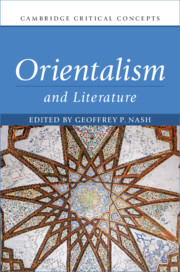Book contents
- Orientalism and Literature
- Cambridge Critical Concepts
- Orientalism and Literature
- Copyright page
- Contents
- Contributors
- Acknowledgments
- Introduction
- Part 1 Origins
- Part II Development
- Chapter 8 Said, Bhabha and the Colonized Subject
- Chapter 9 The Harem: Gendering Orientalism
- Chapter 10 Orientalism and Middle East Travel Writing
- Chapter 11 Nineteenth- and Twentieth-Century American Orientalism
- Chapter 12 Edward Said and Resistance in Colonial and Postcolonial Literatures
- Chapter 13 Can the Cosmopolitan Writer Be Absolved of Racism?
- Part III Application
- Further Reading
- Index
Chapter 10 - Orientalism and Middle East Travel Writing
from Part II - Development
Published online by Cambridge University Press: 01 November 2019
- Orientalism and Literature
- Cambridge Critical Concepts
- Orientalism and Literature
- Copyright page
- Contents
- Contributors
- Acknowledgments
- Introduction
- Part 1 Origins
- Part II Development
- Chapter 8 Said, Bhabha and the Colonized Subject
- Chapter 9 The Harem: Gendering Orientalism
- Chapter 10 Orientalism and Middle East Travel Writing
- Chapter 11 Nineteenth- and Twentieth-Century American Orientalism
- Chapter 12 Edward Said and Resistance in Colonial and Postcolonial Literatures
- Chapter 13 Can the Cosmopolitan Writer Be Absolved of Racism?
- Part III Application
- Further Reading
- Index
Summary
In his posthumous satirical Dictionnaire des idées reçues, Gustave Flaubert (1821–1880) defined an Orientalist as “a man who has traveled a lot.”1 Flaubert may have been lampooning the cliché figure of the Orientalist, but his mocking characterization aptly captures the intimate relation between Orientalism and Middle East travel writing. Indeed, at the origin of Orientalism are the numerous travelogues by European travelers to the Middle East. Although Europe’s geopolitical interest in the Middle East dates back at least to the days of crusades in the eleventh century, starting in the late seventh century European travelers to the Middle East produced a substantial body of literature about the region, describing its geography, people, languages and cultures, which facilitated the rise of modern Orientalism both as an academic discipline and as a discourse of power. Indeed, modern Orientalism would have not been possible without travel literature, for, to understand and write about the Orient, Europeans had to first explore the region as travelers.
- Type
- Chapter
- Information
- Orientalism and Literature , pp. 185 - 201Publisher: Cambridge University PressPrint publication year: 2019



